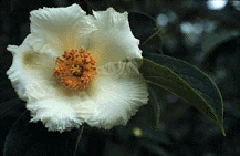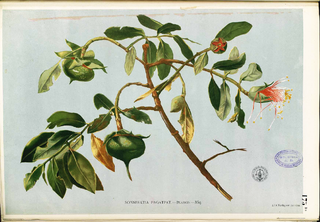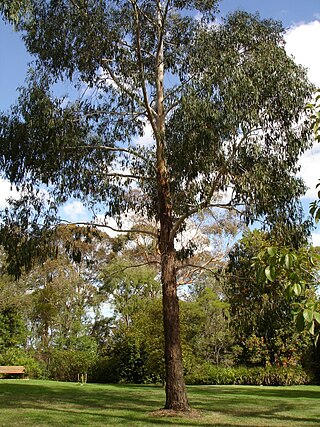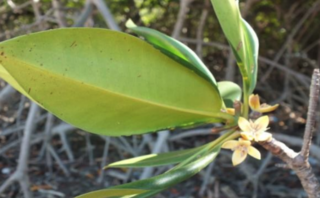
Stewartia ovata, known commonly as mountain camellia, is a small tree native to low to mid-elevations in the southern Appalachian Mountains and nearby regions from Mississippi to Virginia. It is a member of the Theaceae, the tea family.

Sonneratia is a genus of plants in the family Lythraceae. Formerly the Sonneratia were placed in a family called Sonneratiaceae which included both the Sonneratia and the Duabanga, but these two are now placed in their own monotypic subfamilies of the family Lythraceae. The genus was also named Blatti by James Edward Smith, but Sonneratia had botanical nomenclature priority. Sonneratia species are mangrove trees. The germination is viviparous.

Eucalyptus ovata, commonly known as swamp gum or black gum, is a small to medium-sized tree species that is endemic to south-eastern Australia. It has mostly smooth bark, glossy green, lance-shaped to egg-shaped adult leaves, green flower buds in groups of seven, white flowers and conical to bell-shaped fruit.
Anisophyllea globosa is a tree of Borneo in the family Anisophylleaceae. The specific epithet globosa is from the Latin meaning "round", referring to the fruits.
Atuna cordata is a tree in the Atuna genus of the family Chrysobalanaceae. The specific epithet cordata is from the Latin meaning "heart-shaped", referring to the leaf base.

Kandelia candel is a species of mangrove in the family Rhizophoraceae, found around the coasts of South Asia and Southeast Asia, from western India to Borneo. Populations further east, from Vietnam to Japan were formerly included in K. candel, but are now considered a separate species, K. obovata.

Sonneratia caseolaris, commonly known as mangrove apple, is a species of plant in the family Lythraceae. The fruit is noted for its outward similarity to the persimmon fruit.

Ceriops tagal, commonly known as spurred mangrove or Indian mangrove, is a mangrove tree species in the family Rhizophoraceae. It is a protected tree in South Africa. The specific epithet tagal is a plant name from the Tagalog language.
Chionanthus pluriflorus is a tree in the family Oleaceae. The specific epithet pluriflorus means "many-flowered".
Chionanthus polygamus is a tree in the family Oleaceae. The specific epithet polygamus refers to the tree having both unisexual and bisexual flowers.
Madhuca markleeana is a tree in the family Sapotaceae.
Madhuca motleyana is a tree in the family Sapotaceae. It is named for engineer and naturalist James Motley, who lived and worked in Borneo in the 1850s.
Azadirachta excelsa, commonly known as sentang, is a tree in the mahogany family Meliaceae. The specific epithet excelsa is from the Latin meaning "lofty".
Dysoxylum alliaceum is a tree in the family Meliaceae. The specific epithet alliaceum is from the Latin meaning "onion-like", referring to the smell of the inner bark.
Dysoxylum crassum is a tree in the family Meliaceae. The specific epithet crassum is from the Latin meaning "thick", referring to the parts of the flowers.

Xylocarpus moluccensis is a tree in the family Meliaceae. It is named for the Moluccas archipelago.

Bruguiera parviflora is a tree in the family Rhizophoraceae. The specific epithet parviflora is from the Latin meaning "small flowers".

Rhizophora stylosa, the spotted mangrove, red mangrove, small stilted mangrove or stilt-root mangrove, is a tree in the family Rhizophoraceae. The specific epithet stylosa is from the Latin meaning "stylus form", referring to the flower.

Sonneratia alba is a mangrove tree in the family Lythraceae. The specific epithet alba is from the Latin meaning "white", referring to the flowers.

Ceriops decandra is a mangrove plant of tropical Asia in the family Rhizophoraceae. The specific epithet decandra is from the Greek meaning "ten male", referring to the flower having ten stamens.












